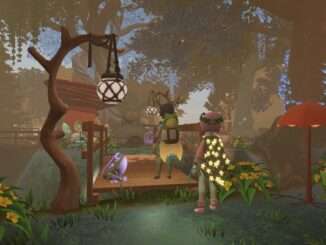
Guide to Irrigation
Irrigation Tips
Wildmender is a sandbox game that makes use of a very transformable map. Early on, players are told how to affect the landscape as a way to expand waterways to spread out the water generated by a Wellstone. Since the water generated far surpasses the demand of plants, bodies of water are going to become extremely common later in the game. However, early on, water conservation is a necessity as there won’t be enough water available for large gardens.
The first big point of advice would be to not do too much gardening or irrigation until players have gained some progress in the game. This could be done by playing through the story, exploring the map, gaining a fair amount of memory points (and memory skills), and finding resources. There are many tools and options for irrigating and gardening more effectively as well as generating more water.
Second, players should plan ahead on how they’d like to proceed with irrigation, if nothing else. By looking for locations to where water will flow naturally, players can make use of the procedurally generated map to help them create wonderful and unique gardens.
There is no “correctway to irrigate, but here are some techniques that can help.
Early Game
Early on, players will have access to water and the Wood and Flint Spades. This is the basic terrain alteration tool. Water will also be very limited as players will not have amassed enough Spiritual Memories to start investing in Wellstone upgrades to increase water output. It is not suggested to commit to the grand work of restoring the map at this point, but some minor landscaping is encouraged.
Digging Waterways
Before they can expand water sources much, Players can leave the small pool they’ll have access to relatively untouched. By leaving a barrier of soil between the future expansion and current pool of water, the small amounts available can pool up and not spread too thin over too much terrain. This effectively causes the well to “dry upbecause the water produced spreads over too much space and evaporates.
When players have started cultivating Trees and using Meadow Mothers, the soil wall can be dropped by digging into it or flattening with the spade.
The effect is similar to having a Dam (or Sluice and Sluice Gate). Alternatively, if the soil wall is slightly lower than the edges of the canal walls, then it’s more like a Spillway. The overflow from the reservoir passes into the waterways beyond the barrier.
If players create a series of spillways and shallow reservoirs, then the reservoirs fill, they overflow into the next reservoir. Similar to filling an ice tray by letting the overflow fill additional ice cube cells. This affords players the time to cultivate as the waterways fill and preserve bodies of water.
By using the Spade’s third skill “Level”, players can make waterways more uniform and smooth (especially if following any compass directions except NW/SE). This same function can be used to create a larger pool for the Oasis early on so that players will not run out of water from Evaporation.
Mid-Game
Mid-game is estimated to be sometime after having rescued both Stryge and Gleb, obtaining their gifts, and learning how to make their respective Biome Mother plants.
Players should be able to upgrade their tools to Obsidian or Starmetal quality. Players may also have invested in Symbiosis and can use Root Sigils.
Players will expand on the early game thought process of examining where to dig and how to guide waterways as well.
Constructing and upgrading Wellstones
Once players have learned the requisite memories for empowering and creating Wellstones themselves instead of just relying on the Mystic wellstones, water production increases massively. Planning ahead expands to looking at the map and understanding the distance that can be covered by cultivating the wellstone network of each Mystic Wellstone. Because Wildmender has the capacity for random maps, understanding where each Mystic wellstone is located is very important since wellstone networks are not additive and can cause issues with water generation if they come into contact.
There seem to be three methods on how to place wellstones. EIther clump them together for easy management or place them scattered about. There are pros and cons to each of these.
Clumping
Pros
- Water is all generated from a similar location and this can reduce evaporation significantly.
- Wellstone output can be upgraded and regulated quicker as they’re all very close together.
Cons
- This much water produced in one location can quickly flood an area.
- Water produced by a wellstone should not submerge it completely. This could cause a wellstone cluster to have a limited output.
- Upgrades can quickly outstrip whatever reservoir or waterway they’re feeding.
Networked
Pros
- Water is more evenly distributed.
- Less likely to overflow the waterway it feeds.
- Easier to troubleshoot problem areas.
- Easier to connect waterways with other wellstone networks.
Cons
- More surface area is subject to evaporation.
- Upgrades and regulation are slower.
- Wellstones may stop or severely slow production of water when Players are out of range.
- Easier to accidentally overlap with other wellstone networks.
Hybrid
Pros
- Water is distributed, but not exactly stretched out.
- Faster upgrade/flow adjustment.
Cons
- Not as much area covered by wellstone generation.
- Multiple upgrades can cause overflows quickly.
Earthwright’s Chisel
This gift from the Deity Gleb is arguably the most powerful tool in the Player’s arsenal. It is a kind of “Power Spadein that it raises, lowers, and levels in much larger volumes of terrain.
Players are advised to not make too large of a change in elevation at one time could cause the terrain mesh to be paralyzed or resistant to changes made with a spade. All abilities can cause massive damage to any plants and structures in the area affected and can cause mass devastation to gardens. This is a large reason to plan ahead before planting any plants or building structures.
Note: may be better to have it on the Chisel Page.
Fissure
This ability carves a straight line through the terrain mesh. The first stake denotes where to end and the second denotes where to start. The terrain will then modify from the second stake to the first. If the first stake is lower than the second, the path will carve much deeper in the terrain (needs checked). A shallow trench is made if used in a way that doesn’t cut too deeply into the terrain.
Raise
This ability raises an enclosed polygon of terrain. When placing stakes, the area tries to raise to the highest placed stake in the polygon. The polygon will reset if lines are placed too far from the previous stake. Once placed, the terrain will begin to fill in from rows going South to North, West to East. If the area raised is level, it will raise by RaiseBaseAmount.
Earthquake
This ability is a charge-able, large-scale Level Terrain ability. It will bring the area enclosed in the displayed circle to the level that the center is at. The longer it’s charged, the greater the area affected. Can be useful to mass-clear wraith stones, outposts, and vegetation. It can also be used to unfreeze shocked terrain mesh if it’s unresponsive to being the spade.
Late Game
Towards the end of the gameplayers will have acquired all gifts from Deities and gotten enough memories to unlock all options for irrigation and restoration.
Life Flames should be utilized to cause mass restoration of areas.as well as restore & open any remaining wellstones.
Using previously learned skills, players can create many kinds of waterways and irrigation systems.
Bodies of water
Now that players have access to fully upgraded wellstones, bodies of water can be easily created. Deeper water will last longer since water evaporates based off exposed surface area. This allows for more reliable waterways that are less likely to dry up. It can also be a nice terrain feature that breaks up expanses of trees.
Humidity
This mechanic is a field that surrounds the source and provides plants within the affected area with enough water to live, grow, and recover health. It does not provide enough water for plants to produce fruit or seed items. Wellstones and Weeping Witchwood are the only two known sources of Humidity.
Pipes and Windmills
Since Pipes and windmills require their input to be submerged, creating bodies of water can allow for water to be carried long distances where no wellstones are available or could possibly reach.
Root Sigils
These act like a mycorrhizal network or a network of mycelium that balances nutrients and water. They balance the water values within it’s range pulling water values from donor plants and moving it through itself to other plants that need it.
By combining these with Pipes or Humidity, players can further extend the influence of water beyond wet ground or the range of humidity.
In fact, it is possible to create water values and distribute that from humidity through Root Sigils. The sigil must simply pull from a plant within a humid area while not being located in the humid region. If the Root Sigil is placed within that area of humidity, it will have nothing to balance.
Clean Springs (Formerly Dirty/Noxious/Poisonous Springs)
Typically just used for a quick water source, players can begin using these springs to create small gardens of life once they can purify them with the Flame Talisman. Before cleansing them, players may end up poisoning the plants that are watered by it. These springs generally do not produce much water through overflowing.





Be the first to comment